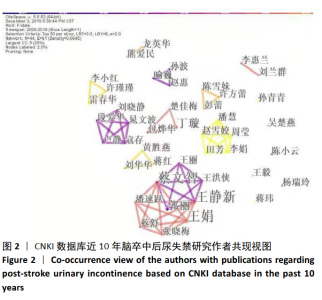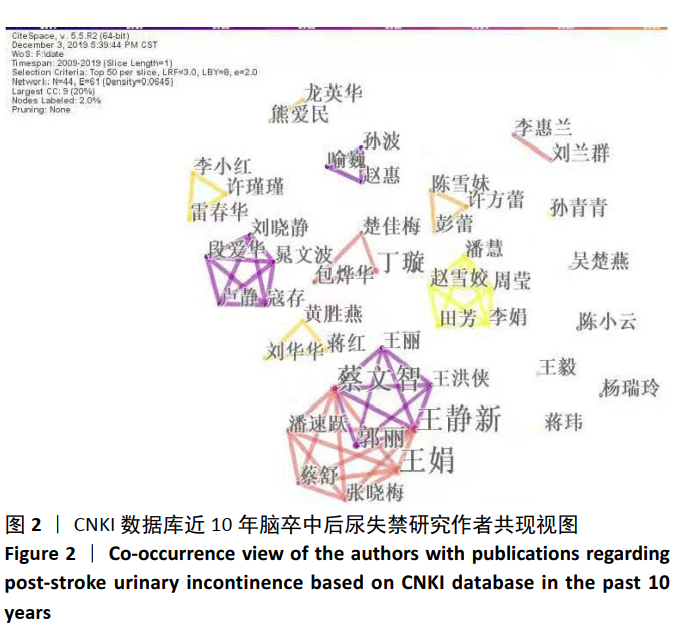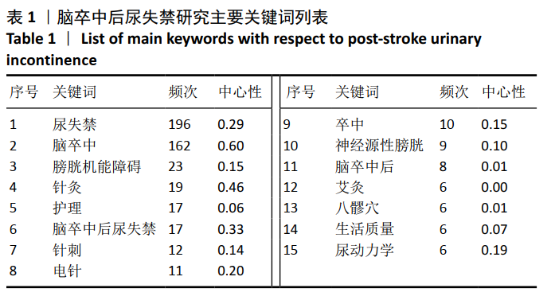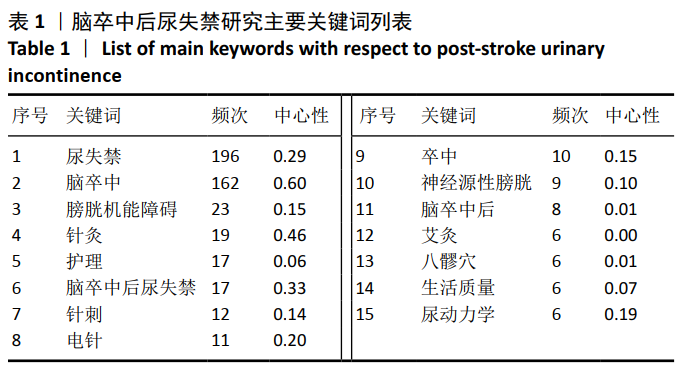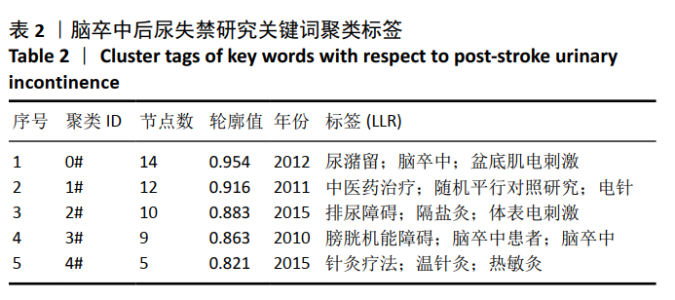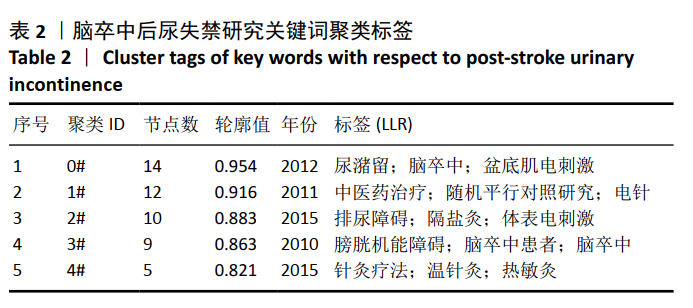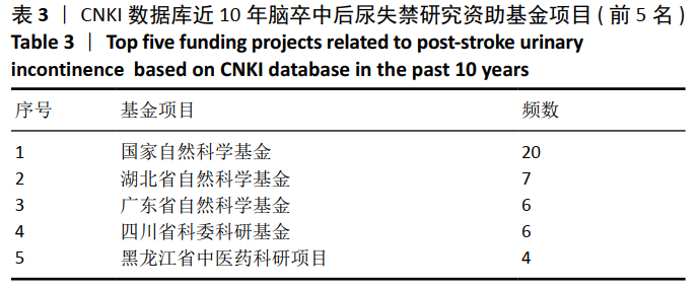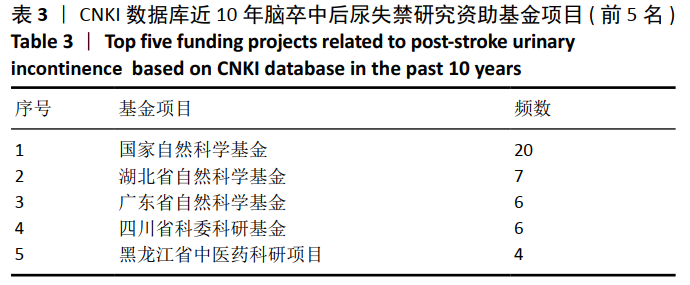Chinese Journal of Tissue Engineering Research ›› 2021, Vol. 25 ›› Issue (35): 5676-5681.doi: 10.12307/2021.299
Previous Articles Next Articles
Visual analysis of literature regarding post-stroke urinary incontinence in the past 10 years
Guo Wen1, Leng Jun2, Liu Huimin1, Zhang Chen1, Fang Xiaolei1, Wei Fangyue3
- 1School of Rehabilitation, Shandong University of Traditional Chinese Medicine, Jinan 250000, Shandong Province, China; 2Rehabilitation Hospital, Second Affiliated Hospital of Shandong University of Traditional Chinese Medicine, Jinan 250001, Shandong Province, China; 3Shandong Provincial Third Hospital, Jinan 250031, Shandong Province, China
-
Received:2020-08-05Revised:2020-08-07Accepted:2020-10-16Online:2021-12-18Published:2021-08-05 -
Contact:Leng Jun, Associate chief physician, Master’s supervisor, Rehabilitation Hospital, Second Affiliated Hospital of Shandong University of Traditional Chinese Medicine, Jinan 250001, Shandong Province, China -
About author:Guo Wen, Master candidate, School of Rehabilitation, Shandong University of Traditional Chinese Medicine, Jinan 250000, Shandong Province, China -
Supported by:the Scientific Developmental Plan for Traditional Chinese Medicine in Shandong Province, No. 2017-104 and 2019-0247 (both to LJ)
CLC Number:
Cite this article
Guo Wen, Leng Jun, Liu Huimin, Zhang Chen, Fang Xiaolei, Wei Fangyue. Visual analysis of literature regarding post-stroke urinary incontinence in the past 10 years[J]. Chinese Journal of Tissue Engineering Research, 2021, 25(35): 5676-5681.
share this article
Add to citation manager EndNote|Reference Manager|ProCite|BibTeX|RefWorks
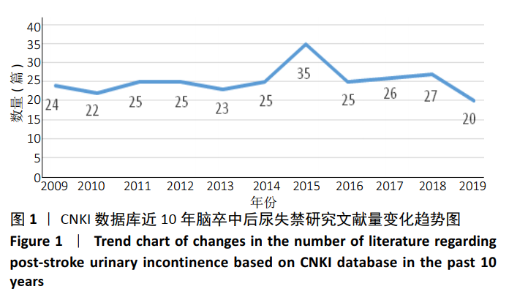
2.1 年发文量分析 分析某一领域的发展水平,可通过观察每年度的文献发表量的情况而得知。文章按照发表时间,对纳入研究的227篇文献进行了统计,见图1。由图1可知,脑卒中后尿失禁研究的发文量在25篇/年左右,就发文量来说相对稳定,形成了一定的研究规模,在2015年多地开展了相关领域的学术会议,涌现了许多优秀论文。但是文章数量整体基数较小,表明目前关于脑卒中后尿失禁的研究还未取得重大科研成果。原因可能为中医治疗更看重临床疗效,而脑卒中后尿失禁的相关理论尚未开展深入的科研工作[17]。而且此次研究对文献质量有一定要求,在检索时就筛除了不符合要求的期刊文章,因此不能全面准确地说明脑卒中后尿失禁的研究现状。虽然此次研究未纳入2009年之前的文献,但大致可推测出在此之前,关于脑卒中后尿失禁的研究已经进入了萌芽阶段。"
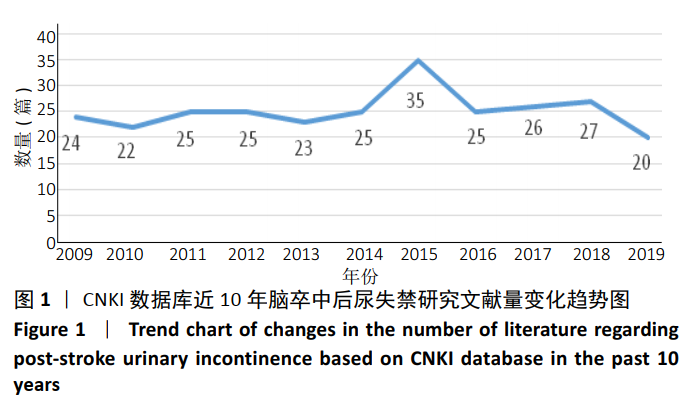
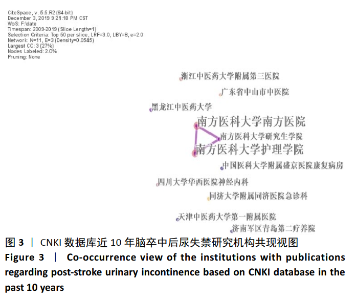
图2中的节点代表发文量≥2篇的作者,其中节点越大,代表该作者的发文量越多,反之则代表着较少的发文量。各个作者之间的连线也具有一定意义,可折射出不同作者间的联系或合作关系,线条越粗说明联系越密切,存在合作的研究越多[19]。由此可知中风后尿失禁领域已经形成了多个研究团队,这其中最稳定的是以王静新、蔡文智为首的团队,其特点是发文量较高、团队内成员联系较为紧密。但是总体来说此领域研究团队分散,彼此联系不紧密,团队间合作较少。 2.3 机构共现分析 探究某领域的科研力量的分布情况以及研究阵地的最好方法就是对文献进行机构的共现分析[20],见图3。图3中共有11所机构被纳入,其中有2所机构发文量≥4篇。由图3可知,对脑卒中后尿失禁关注较密切的机构有南方医科大学及其附属医院、浙江中医药大学附属第三医院、中山市中医院、黑龙江中医药大学、中国医科大学附属盛京医院等。图中连线情况说明各研究机构相对独立,不存在科研合作;同时研究机构都分属不同的省份或地域,这样就对此领域发展造成了地域上的局限性[21],不能及时交流最新研究成果,限制此学科的发展。"
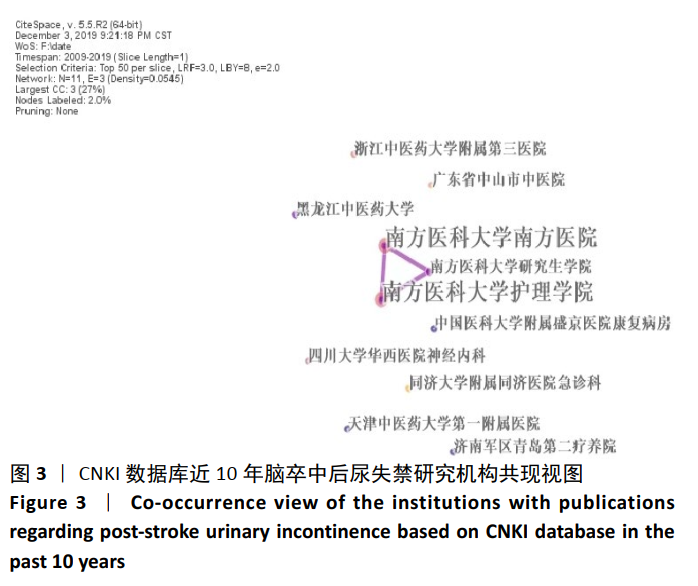
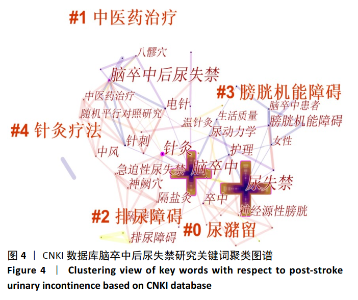
2.4 关键词共现分析 关键词可表达所研究文献内容的核心,而频次较高的关键词能展示出该领域的研究焦点[22]。对关键词进行共现分析,可了解这一领域的整体内容。根据不同阶段出现的关键词,可知晓该领域的总体发展情况,并对其未来趋势做出预测[23]。图4中,对脑卒中后尿失禁的关键词进行分析,图谱中有56个共现关键词,总计频次604次,出现频次≥6的主要关键词见表1。中心性是测量某个点在多大程度上位于图中与之联系的点的中心位置,该点的中介作用和数值成正比关系[16],即某一节点的中心性的数值越高,则对其他节点的影响越大,其地位就越重要[24]。因此,作为标识某领域研究热点的重要指标,中心性主要反映其核心内容。文章通过高频词和中心性,结合关键词共现分析,对脑卒中后尿失禁的热点进行挖掘。表1中15个关键词均具有所获研究者关注度较高、对此领域影响力深、持续时间长等特点,由此可见,高频关键词中除直接涉及“脑卒中”与“尿失禁”外,排名在前15的高频关键词主要与中医治疗相关,如“针灸”“针刺”“艾灸”“八髎穴”等,说明目前在脑卒中后尿失禁的临床治疗中,中医治疗的普及程度更高,更易获得研究者的关注;而理论研究相对较少,并没有大量开展。"
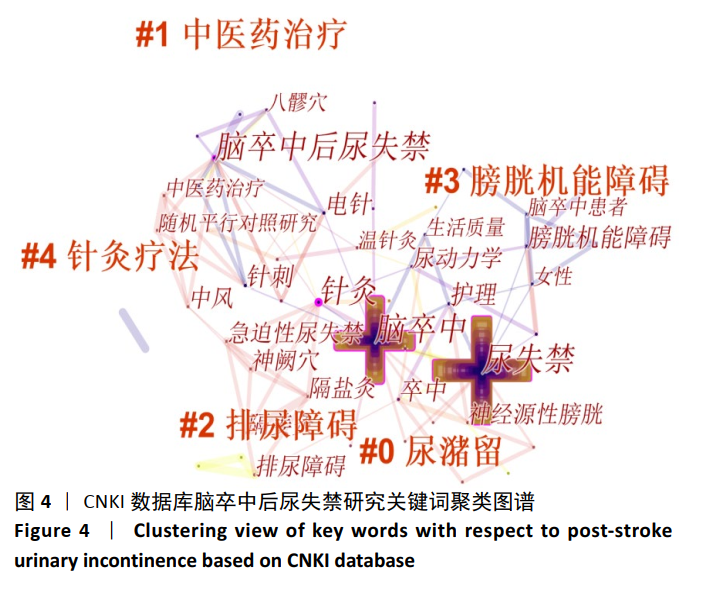
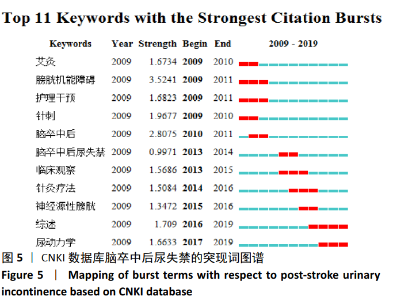
2.5 研究前沿及发展趋势 突现词是指利用词频的记录,从主题词中挑选出在特定时间内变化率高的词[25],一定程度上可预测此领域未来的发展趋势。由图5可知,脑卒中后尿失禁的研究在不同时期有不同的研究热点,突现词持续时间≥3年以上的主要有膀胱机能障碍、护理干预、临床观察、针灸疗法、综述、尿动力学。由图5分析发现脑卒中后尿失禁的研究热点转移情况,自2009年对艾灸、膀胱机能障碍、护理干预研究的兴起,2013年转为对临床治疗和针灸疗法的研究,近年来着重注意理化指标,对神经源性膀胱和尿动力学展开研究,因此有持续作为研究热点的可能。通过分析可知,此领域研究内容在不断转变,由护理干预转为临床观察,再发展为系统综述和循证医学,同时其研究内容也随之细化、深化[26],不仅仅追求临床效果,更强调其治疗机制的明确。"
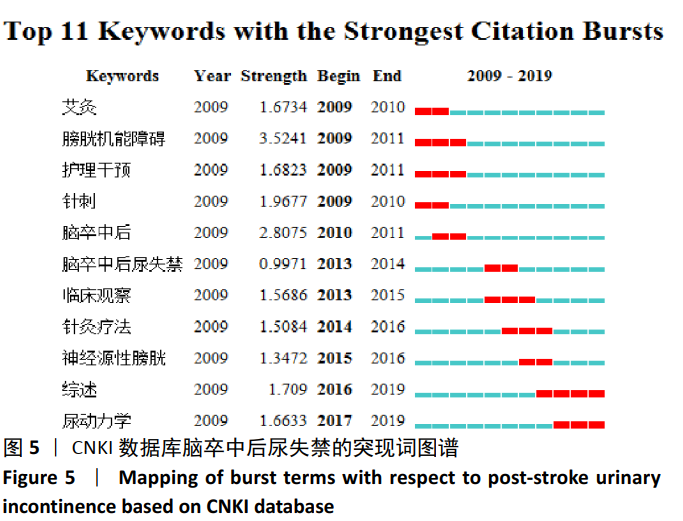
| [1] 何文亭,邢向娈,高焕民.中风发病机制的肝源说[J].医学争鸣,2017, 8(5):33-36. [2] PEI J, YOU X, FU Q. Inflammation in the pathogenesis of ischemic stroke. FrontBiosci (Landmark Ed). 2015;20:772-783. [3] ZHU LH, ZHANG ZP, WANG FN, et al. Diffusion kurtosis imaging of microstructural changes in brain tissue affected by acute ischemic stroke in different locations. Neural Regen Res. 2019;14(2):272-279. [4] BAUER SR, GRIMESB, SUSKINDAM, et al. Urinary Incontinence and Nocturia in Older Men: Associations with Body Mass, Composition and Strength in the Health ABC Study. J Urol. 2019;202(5):1015-1021. [5] HERON M, HOYERTDL, MURPHYSL, et al. Deaths:finaldata for 2006. Natl Vital Stat Rep. 2009;57(14):130-134. [6] BROWN JS, VITTINGHOFF E, WYMAN JF, et al. Urinaryincontinence:does it increase risk for falls and fractures?Study of Osteoporotic Fractures Research Group. J Am GeriatrSoc. 2000;48(7):721-725. [7] JOHN G, BARDINIC, MÉGEVAND P, et al. Urinary incontinence as a predictor of death after new-onset stroke: a meta-analysis. Eur J Neurol. 2016;23:1548-1555. [8] ROTARM, BLAGUSR, JEROMELM, et al. Stroke patients who regain urinary continence in the first week after acute first-ever stroke have better prognosis than patients with persistent lower urinary tract dysfunction. Neurourol Urodyn. 2011;30(7):1315-3151. [9] 何云燕,邹媛.脑卒中后尿失禁的治疗与护理现状[J].天津护理, 2018,26(5):619-620. [10] 刘兰群,李惠兰.脑卒中后排尿障碍的中西医治疗[J].中国康复理论与实践,2013,19(11):1036-1038. [11] ZHOU W, KOU AQ, CHEN J, et al. A retrospective analysis with bibliometric of energy security in 2000–2017. Energy Reports. 2018;(4): 724-732. [12] 陈悦,陈超美,侯剑华,等.CiteSpace 知识图谱的方法论功能[J].科学学研究,2015,33(2):242-253. [13] 魏娜敏,杜柏,石晶晶,等.中医“天癸”相关研究知识图谱分析[J].江苏中医药,2019,51(2):73-77. [14] YANG Y, MENG GF. A bibliometric analysis of comparative research on the evolutionof international and Chinese ecological footprint research hotspots and frontiers since 2000. Ecological Indicators. 2019;(102):650-665. [15] 李慧军,魏翠兰, 李垂坤,等.Citespace软件可视化分析运动与认知[J].中国组织工程研究,2020,24(14):2277-2283. [16] CHEN CHAOMEI. Cite SpaceII:Detecting and visualizing emerging trends and transient patterns in scientific literature. J Am Soc Inf Sci Technol. 2006;57(3):359-377. [17] 章小燕,雷黄伟,周常恩,等.基于CiteSpace的中医胆石症知识图谱可视化分析[J].中医药信息,2019,36(5):17-20. [18] 王梅,裴文杰,马韶君.我国研究生教育研究领域作者合作网络的特征分析——基于CSSCI数据库的可视化研究(2001-2015)[J].研究生教育研究,2017(6):29-35. [19] 王富祥.基于知识图谱的大数据研究可视化分析[J].华北理工大学学报(社会科学版),2017,17(1):56-62. [20] 秦义,田元祥.基于 CiteSpace 的气虚证证候诊断标准知识图谱可视化分析[J].中医杂志,2015,56(18): 1588-1592. [21] 李曌嫱,秦义,田元祥,等.针灸治疗腰椎间盘突出症的CiteSpace知识图谱可视化分析[J].中国针灸,2017,37(5):545-548. [22] 王桂琴,方奕,易明.近五年我国青少年研究的前沿演进与热点领域:基于 CiteSpace 研究文献的可视化分析[J].中国青年研究, 2017(12):92-97. [23] 石晶晶,薄荣强,胡元会,等.基于Citespace的中医导引术相关研究的可视化分析[J].中国医药导报,2018,15(4):94-98. [24] DING W, CHEN CM. Dynamic Topic Detection and Tracking: A Comparison of HDP, C-word, and CocitationMethods. J Assoc Inf Sci Technol. 2014;65(10):2084-2097. [25] 齐虹,闫静璇.基于知识图谱的我国信息行为研究态势分析[J].现代情报,2018,38(5):131-139. [26] 于宗良,闫则宇,宋英,等.基于CiteSpace中药治疗类风湿关节炎的知识图谱分析[J].河南中医,2019,39(9):1366-1371. [27] 蒋美荣.深刺八髎穴配合艾灸治疗脑卒中后急迫性尿失禁50例[J].中国民间疗法,2019,27(4):7-8. [28] BROGAN E, LANGDON C, BROOKES K, et al. Can’t swallow, can’t transfer, can’t toilet: Factors predicting infections in the first week post stroke. J Clin Neurosci. 2015;22(1):92-97. [29] GARIBALLA SE. Potentially treatable causes of poor outcome in acute stroke patients with urinary incontinence. Acta Neurol Scand. 2003;107(5):336-340. [30] JOHN G, BARDINIC, COMBESCUREC, et al. Urinary Incontinence as a Predictor of Death: A Systematic Review and Meta-Analysis. Plos One. 2016;11(7):e0158992. [31] 朱远玲,齐会玲,白宝华,等.中医三联疗法治疗腰椎全麻术后尿潴留的临床疗效[J].时珍国医国药,2018,29(4):913-914. [32] 黄斌.穴位埋线结合中药治疗脑梗死后肾气不固型尿失禁的临床疗效研究[D].哈尔滨:黑龙江中医药大学,2017. [33] CHOU YC, JIANG YH, HARNOD T ,et al. Characteristics ofneurogenic voiding dysfunction in cerebellar stroke: across-sectional, retrospective video urodynamic study. Cerebellum. 2013;12(5):601-606. [34] 赵文静.温针灸八髎穴治疗中风后尿失禁的临床研究[D].武汉:湖北中医药大学,2019. [35] 张静,黄明辉.新型拔管方法在老年男性患者留置导尿中的循证护理实践[J].中国老年保健医学,2019,17(5):131-133. [36] GELBER DA, GOOD DC, LAVEN LJ, et al. Causes of urinary incontinence after acute hemispheric stroke. Stroke. 1993;24(3):378-382. [37] 刘兰群,李惠兰,陈之罡,等.隔盐隔姜灸神阙穴治疗脑卒中后急迫性尿失禁的效果观察[J].中国康理论与实践,2015,21(4):475-478. [38] 蔡文智,郭丽,王丽,等.广州市脑卒中住院患者尿失禁相关因素的调查研究[J].护理学报,2012,19(12):1-6. [39] 郭丽,王静新,王丽,等.脑卒中后尿失禁住院患者排尿情况及膀胱管理分析[J].中国护理管理,2012,12(5):33-36. [40] 王娟,蔡文智,王静新,等.急性脑卒中患者预后相关因素分析[J].中华神经医学杂志,2015,14(9):927-931. [41] 胡益娟,钟冬灵,陈强,等.基于CiteSpace软件的国内近15年慢性稳定性心绞痛研究的文献计量及可视化分析[J].中国循证医学杂志,2020,20(5):568-575. [42] 华强,夏文广,种玉飞,等.腹针配合盆底肌电生物反馈治疗脑梗死后尿失禁的疗效观察[J].上海针灸杂志,2020,39(7):844-850. [43] 潘才钰,程一升,吴志鹏,等.间歇导尿联合针刺治疗脑卒中后神经源性膀胱的疗效观察[J].中国现代医生,2013,51(30):94-96. [44] 金翊思,金春华,张桂珍,等.膀胱训练计划配合项针治疗卒中后尿失禁临床研究[J].河南中医,2014,34(3):510-512. [45] 娄政驰,赵艳青,黄丽.基于 Citespace 软件分析 Web of science 数据库中针灸治疗中风研究的文献计量学规律[J].中医药信息, 2019,36(3):14-22. |
| [1] | Wang Mengting, Gu Yanping, Ren Wenbo, Qin Qian, Bai Bingyi, Liao Yuanpeng. Research hotspots of blood flow restriction training for dyskinesia based on visualization analysis [J]. Chinese Journal of Tissue Engineering Research, 2021, 25(8): 1264-1269. |
| [2] | Luo Lin, Song Naiqing, Huang Jin, Zou Xiaodong. Review and prospect of international research on preschool children’s movement development assessment: a CiteSpace-based visual analysis [J]. Chinese Journal of Tissue Engineering Research, 2021, 25(8): 1270-1276. |
| [3] | Yuan Mei, Zhang Xinxin, Guo Yisha, Bi Xia. Diagnostic potential of circulating microRNA in vascular cognitive impairment [J]. Chinese Journal of Tissue Engineering Research, 2021, 25(8): 1299-1304. |
| [4] | Zhang Jiaming, Tian Yanping, Zhang Yue, Zhong Dongling, Li Yuxi, Zheng Zhong, Li Juan, Jin Rongjiang. Visual analysis of literature on transcranial magnetic stimulation for stroke based on Citespace knowledge map [J]. Chinese Journal of Tissue Engineering Research, 2021, 25(35): 5610-5618. |
| [5] | Hui Xiaoshan, Zhang Jinsheng, He Qingyong, Wang Shiqi, Yang Shuai, Zhang Hui, Wang Jie. Cardiomyocyte direct reprogramming: a scientometric and visualization analysis based on the Web of Science [J]. Chinese Journal of Tissue Engineering Research, 2021, 25(32): 5123-5131. |
| [6] | Bai Fuyu, Wang Mengqi, Xue Feng, Li Zhenrui, Yan Qinghao, Zhang Zhiyi, Wang Feng. Characteristics of randomized controlled trials on acupuncture for stress urinary incontinence in women [J]. Chinese Journal of Tissue Engineering Research, 2021, 25(32): 5197-5203. |
| [7] | Yuan Chunhua, Cui Zhenzhen, Wu De. Meta-analysis of autologous bone marrow mesenchymal stem cell transplantation in the treatment of ischemic stroke [J]. Chinese Journal of Tissue Engineering Research, 2021, 25(31): 5018-5024. |
| [8] | Ren Tengzhou, Chen Jie, Zhao Wei, Chen Zhiwei, Zhang Teng, Wang Yan. Applicability of stem cells in the treatment of stress urinary incontinence [J]. Chinese Journal of Tissue Engineering Research, 2021, 25(25): 4058-4064. |
| [9] | Fan Jin, Zeng Luyao, Zhong Dongling, Li Yuxi, Tian Yanping, Huang Yijie, Jin Rongjiang. Development of functional near-infrared spectroscopy in recent 10 years: a visual analysis using CiteSpace [J]. Chinese Journal of Tissue Engineering Research, 2021, 25(23): 3711-3717. |
| [10] | Yang Qin, Zhou Honghai, Chen Longhao, Zhong Zhong, Xu Yigao, Huang Zhaozhi. Research status and development trend of pelvic reconstruction techniques: a bibliometric and visual analysis [J]. Chinese Journal of Tissue Engineering Research, 2021, 25(23): 3718-3724. |
| [11] | Huang Maomao, Hu Yue, Wang Binchuan, Zhang Chi, Xie Yujie, Wang Jianxiong, Wang Li, Xu Fangyuan. Bibliometric and visual analysis of international literature addressing ischemic stroke rehabilitation in recent 10 years [J]. Chinese Journal of Tissue Engineering Research, 2021, 25(23): 3725-3733. |
| [12] | Zhu Rui, Zeng Qing, Huang Guozhi. Ferroptosis and stroke [J]. Chinese Journal of Tissue Engineering Research, 2021, 25(23): 3734-3739. |
| [13] | Bao Sairong, Lin Lihua, Shan Sharui, Yang Xingping, Liu Chunlong. Effect of electrical deep muscle stimulate on muscle tone, elasticity, and stiffness of biceps brachii in stroke patients [J]. Chinese Journal of Tissue Engineering Research, 2021, 25(20): 3138-3143. |
| [14] | Li Wenhui, Liu Guobin. Knowledge mapping analysis on the international research of diabetic foot: a visual analysis based on CiteSpace [J]. Chinese Journal of Tissue Engineering Research, 2021, 25(20): 3178-3184. |
| [15] | Wei Jinqiang, Huang Dengcheng, Cao Xuewei, Zhou Jianwei, Sun He, Li Zehui. Analysis of researches on TCM treatments for cartilage diseases in recent 20 years by mapping knowledge domains [J]. Chinese Journal of Tissue Engineering Research, 2021, 25(20): 3202-3209. |
| Viewed | ||||||
|
Full text |
|
|||||
|
Abstract |
|
|||||
